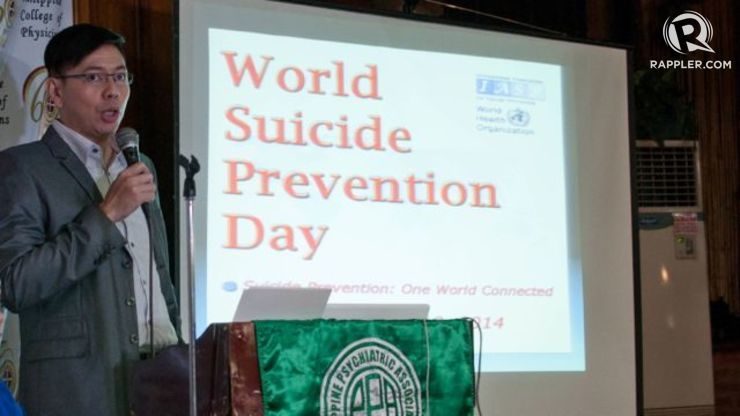SUMMARY
This is AI generated summarization, which may have errors. For context, always refer to the full article.

As World Suicide Prevention Day is observed September 10, psychiatrists stress the need to dispel myths about suicide and to use media to help vulnerable individuals
MANILA, Philippines – When Kate Alvarez’s psychiatrist told her she had general anxiety disorder, she accepted the diagnosis and resolved to get better.
With a fiancé who loved her and a successful career as a commercial model, she had enough reason to fight for her health.
“For one year, I took therapy. I wanted to get better because I had a great life. [My boyfriend and I] were going to get married. I wanted to be good for him, and to be good to myself. I didn’t want to be a psychiatric patient forever.”
Her hard work paid off. In September 2012, she was allowed to go off her medication.
But on October 5, 2012, only a month after she finally beat her disorder, her fiancé jumped off a hotel to his death. Miguel (not his real name) had been exhibiting signs of clinical depression, but Alvarez did not know then how to recognize them.
“Here I was, curing my general anxiety disorder, while he was clinically depressed. I knew nothing about clinical depression. I didn’t know the signs. I wasn’t educated. And in the media, we just report suicides as drama,” she shared at a forum on Tuesday, September 9.
Miguel had talked about suicide, but Alvarez thought it was a joke. It’s a common misconception, doctors say, that those who talk about killing themselves are never really serious, and are simply trying to get attention.
As countries all over the globe observe World Suicide Prevention Day on September 10, psychiatrists stressed the need to dispel myths about suicide and to use media to help vulnerable individuals.
At Tuesday’s forum, experts said more lives could be saved each year if people know how to spot suicidal tendencies in their loved ones.
 The emphasis on connectedness underscores its role in helping at-risk individuals, said psychiatrist Rene Samaniego, public relations officer of the Philippine Psychiatric Association.
“Social isolation is one important risk factor of suicide,” Samaniego added.
A notable highlight in this year’s observation of WSPD is the release of the WHO’s World Suicide Report, which gives an outline of the most recent data of suicide rates globally, major risk factors, and strategies on suicide prevention.
Responsible reporting
Over the years, research has established media’s role in helping prevent suicide.
Studies show that extensive and sensationalist media reporting of suicide can induce copycat behavior among vulnerable individuals.
Samaniego said it’s time for media to recognize its power in either perpetuating or preventing suicide by choosing to report responsibly and ethically.
Among other things, reporters are asked to provide information about suicide hotlines and to take care not to fuel speculation about the cause of death, especially in high-profile cases like celebrity suicides.
Reporters should also avoid language that glorifies suicide and giving overt descriptions and details of the suicide method or site to prevent possible copycat attempts.
In the case of her fiancé’s death, Alvarez said she found that Miguel had researched about the site of his suicide on his iPad.
A quick Google search had led him to news reports about two others who had completed suicide in the same hotel.
“The articles that media wrote came up, saying this was the hotel where so-and-so [died]. So that’s where he went,” she said.
Alvarez called on media to be careful about what they write. She also asked media not to forget that they are writing about a person, whom readers might unfairly judge based on the manner of his death.
“At first I was angry. Seeing it on the news made his death real. I thought…people are going to talk about it, they are going to judge him by that one act,” she said.
“[But] he is more than his suicide. He is a person. He had a lot of great values, and he was successful in his work. It’s just this one ailment that cost him his life.”
‘Deleting’ the cause
In the months leading up to that day in October 2012, Miguel was preparing to to fulfill his lifelong dream of becoming a certified airline pilot.
But he was worried about his performance in the training. He started exhibiting the signs of depression: he couldn’t sleep at night, started isolating himself from friends, and took up smoking.
“He started having delusions that he was failing,” Alvarez said.
Alvarez did all she could for him. She helped Miguel make a list of who to live for, and she told him to look at the list whenever he felt sad. She would send him inspiring quotes and articles about relaxation.
When Miguel spoke of suicide, Alvarez slept over at his house and watched over him while he talked about his worries.
But nothing worked. Finally, two days before Miguel took his own life, Alvarez called up Miguel’s uncle, who worked at the airline. It was from him that she learned that Miguel was actually doing well and was set to pass his training.
Alvarez thought the news would “delete” the cause of Miguel’s worries. So after a week of watching over him, she finally decided to go home on the night of October 4th.
“I was like a nurse, checking up on him. So that night, I thought I deleted the cause, and I felt like I could rest because I was so tired myself,” she said.
She checked up on him later that night, asking if he felt better now that he knew he had nothing to worry about. She didn’t get the answer she hoped for.
“I asked, ‘Do you feel better now you know that you’re not failing?’ His answer: ‘Kinda.’ That wasn’t the answer I was expecting.”
“But then I left him. Up to this day, I’d wonder: if I didn’t leave him, would he still be here? Because on October 5, at 5 am, he jumped.”
Getting help
A year after she beat her general anxiety disorder, Alvarez went back on medication: in the summer of 2013, months after Miguel died, she was diagnosed with clinical depression.
The emphasis on connectedness underscores its role in helping at-risk individuals, said psychiatrist Rene Samaniego, public relations officer of the Philippine Psychiatric Association.
“Social isolation is one important risk factor of suicide,” Samaniego added.
A notable highlight in this year’s observation of WSPD is the release of the WHO’s World Suicide Report, which gives an outline of the most recent data of suicide rates globally, major risk factors, and strategies on suicide prevention.
Responsible reporting
Over the years, research has established media’s role in helping prevent suicide.
Studies show that extensive and sensationalist media reporting of suicide can induce copycat behavior among vulnerable individuals.
Samaniego said it’s time for media to recognize its power in either perpetuating or preventing suicide by choosing to report responsibly and ethically.
Among other things, reporters are asked to provide information about suicide hotlines and to take care not to fuel speculation about the cause of death, especially in high-profile cases like celebrity suicides.
Reporters should also avoid language that glorifies suicide and giving overt descriptions and details of the suicide method or site to prevent possible copycat attempts.
In the case of her fiancé’s death, Alvarez said she found that Miguel had researched about the site of his suicide on his iPad.
A quick Google search had led him to news reports about two others who had completed suicide in the same hotel.
“The articles that media wrote came up, saying this was the hotel where so-and-so [died]. So that’s where he went,” she said.
Alvarez called on media to be careful about what they write. She also asked media not to forget that they are writing about a person, whom readers might unfairly judge based on the manner of his death.
“At first I was angry. Seeing it on the news made his death real. I thought…people are going to talk about it, they are going to judge him by that one act,” she said.
“[But] he is more than his suicide. He is a person. He had a lot of great values, and he was successful in his work. It’s just this one ailment that cost him his life.”
‘Deleting’ the cause
In the months leading up to that day in October 2012, Miguel was preparing to to fulfill his lifelong dream of becoming a certified airline pilot.
But he was worried about his performance in the training. He started exhibiting the signs of depression: he couldn’t sleep at night, started isolating himself from friends, and took up smoking.
“He started having delusions that he was failing,” Alvarez said.
Alvarez did all she could for him. She helped Miguel make a list of who to live for, and she told him to look at the list whenever he felt sad. She would send him inspiring quotes and articles about relaxation.
When Miguel spoke of suicide, Alvarez slept over at his house and watched over him while he talked about his worries.
But nothing worked. Finally, two days before Miguel took his own life, Alvarez called up Miguel’s uncle, who worked at the airline. It was from him that she learned that Miguel was actually doing well and was set to pass his training.
Alvarez thought the news would “delete” the cause of Miguel’s worries. So after a week of watching over him, she finally decided to go home on the night of October 4th.
“I was like a nurse, checking up on him. So that night, I thought I deleted the cause, and I felt like I could rest because I was so tired myself,” she said.
She checked up on him later that night, asking if he felt better now that he knew he had nothing to worry about. She didn’t get the answer she hoped for.
“I asked, ‘Do you feel better now you know that you’re not failing?’ His answer: ‘Kinda.’ That wasn’t the answer I was expecting.”
“But then I left him. Up to this day, I’d wonder: if I didn’t leave him, would he still be here? Because on October 5, at 5 am, he jumped.”
Getting help
A year after she beat her general anxiety disorder, Alvarez went back on medication: in the summer of 2013, months after Miguel died, she was diagnosed with clinical depression.
 It was a long and hard struggle to get better. She cut down friends who didn’t understand her situation and thought she was being dramatic.
She also endured insensitive comments from those who did not fully understand the situation of those suffering from mental health problems.
Alvarez recalled how people would tell her that she was weak, or that she didn’t pray hard enough. One nurse even told her, “Magkano binabayad mo sa psychiatrist? Ako na lang bayaran mo, kakausapin kita.” (How much do you pay your psychiatrist? Pay me instead, I’ll just talk to you.)
She also lamented how professional help was inaccessible to people who need them most.
Alvarez said she tested two suicide help hotlines – and there aren’t that many in the Philippines – and only successfully got through to one of them.
She also recalled how the stigma attached to depression and suicide prevented other people from helping Miguel at the height of his depressive days.
“I would call people, but no one believed me. No one would come help me rescue him. They thought, why would someone like him be irrational? He’s a good guy,” she said.
“That’s the thing about suicide, you never know. It’s not always the dramatic people. It could be the nicest, kindest, most intelligent people you know.”
A year since being diagnosed with depression, Alvarez can now say that she has reached a “zero” on her scale of how badly she wanted to die.
But this does not mean the end of her advocacy. Alvarez is a member of the Natasha Goulbourn Foundation, which helps people suffering from depression or feeling suicidal.
“I won’t stop helping people because there are so many out there who have no hope. I’m doing this for Miguel.” – Rappler.com
The Natasha Goulbourn Foundation has a depression and suicide prevention hotline to help those secretly suffering from depression. The numbers to call are 804-4673 and 0917-558-4673. Globe and TM subscribers may call the toll-free number 2919. More information is available on its website. It’s also on Twitter @NGFoundationPH and Facebook.
It was a long and hard struggle to get better. She cut down friends who didn’t understand her situation and thought she was being dramatic.
She also endured insensitive comments from those who did not fully understand the situation of those suffering from mental health problems.
Alvarez recalled how people would tell her that she was weak, or that she didn’t pray hard enough. One nurse even told her, “Magkano binabayad mo sa psychiatrist? Ako na lang bayaran mo, kakausapin kita.” (How much do you pay your psychiatrist? Pay me instead, I’ll just talk to you.)
She also lamented how professional help was inaccessible to people who need them most.
Alvarez said she tested two suicide help hotlines – and there aren’t that many in the Philippines – and only successfully got through to one of them.
She also recalled how the stigma attached to depression and suicide prevented other people from helping Miguel at the height of his depressive days.
“I would call people, but no one believed me. No one would come help me rescue him. They thought, why would someone like him be irrational? He’s a good guy,” she said.
“That’s the thing about suicide, you never know. It’s not always the dramatic people. It could be the nicest, kindest, most intelligent people you know.”
A year since being diagnosed with depression, Alvarez can now say that she has reached a “zero” on her scale of how badly she wanted to die.
But this does not mean the end of her advocacy. Alvarez is a member of the Natasha Goulbourn Foundation, which helps people suffering from depression or feeling suicidal.
“I won’t stop helping people because there are so many out there who have no hope. I’m doing this for Miguel.” – Rappler.com
The Natasha Goulbourn Foundation has a depression and suicide prevention hotline to help those secretly suffering from depression. The numbers to call are 804-4673 and 0917-558-4673. Globe and TM subscribers may call the toll-free number 2919. More information is available on its website. It’s also on Twitter @NGFoundationPH and Facebook.
One death every 40 seconds
Over 800,000 people die by suicide each year around the world, the World Health Organization (WHO) said in a landmark report capping a decade of research on suicide. This roughly translates to one person taking his own life every 40 seconds, with men almost twice as likely as women to take their own lives The Philippines has a low incidence of suicide. Based on 2012 data, the national suicide rate for the Philippines is at 2.7 per 100,000. But most suicide deaths come from the 15-29 and 70+ years age groups, showing a worrying trend of more young Filipinos and the elderly taking their own lives. Child and adolescent psychiatrist Rhea Concepcion also noted that 90% of those who completed suicide had a diagnosable mental disorder at the time of death. While depression is the most common psychiatric disorder associated with youth suicides, Concepcion said other stressors, such as parental pressure and pressure from society, could add to the burden of a vulnerable individual. But she also emphasized that the reasons behind a person’s decision to take his own life is complex, and that suicide is not caused by one single factor. Connectedness is crucial Since 2003, World Suicide Prevention Day (WSPD) has been observed every year to promote awareness about suicide, mental illnesses, and suicide prevention. This year’s theme is “Suicide Prevention: One World Connected.”

Add a comment
How does this make you feel?
Loading
There are no comments yet. Add your comment to start the conversation.